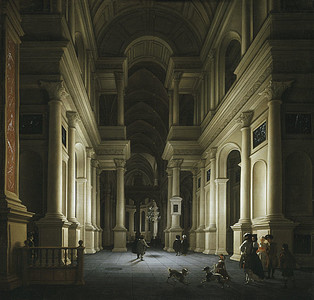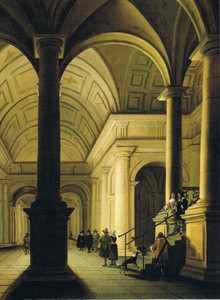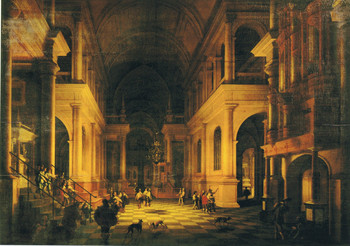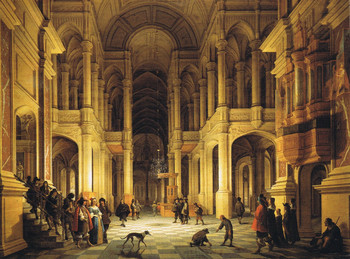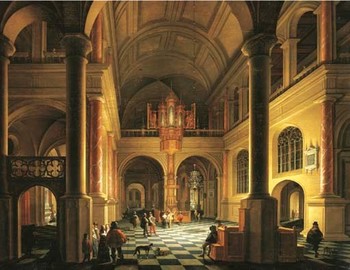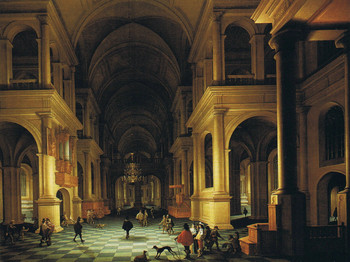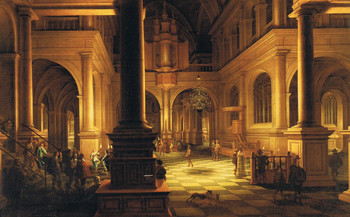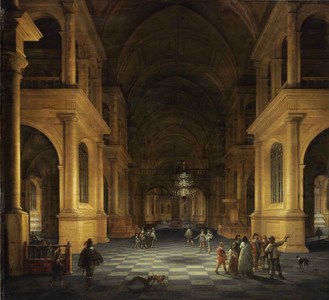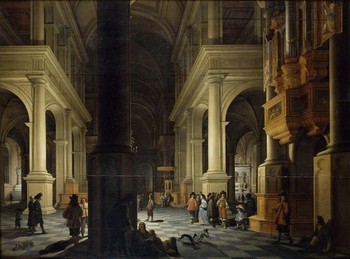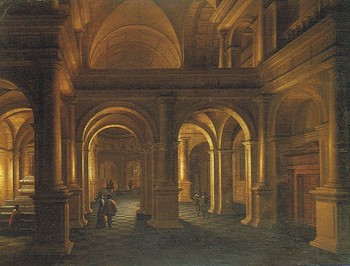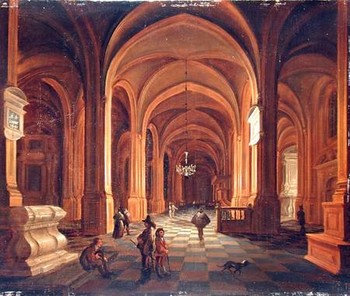10.000 €
Church interior at night
Oil on panel : 86,1 X 70,0 cm
Unsigned
Frame : 112,7 X 95,3 cm
The figures are by Anthonie Palamedesz.
Frame : 112,7 X 95,3 cm
The figures are by Anthonie Palamedesz.
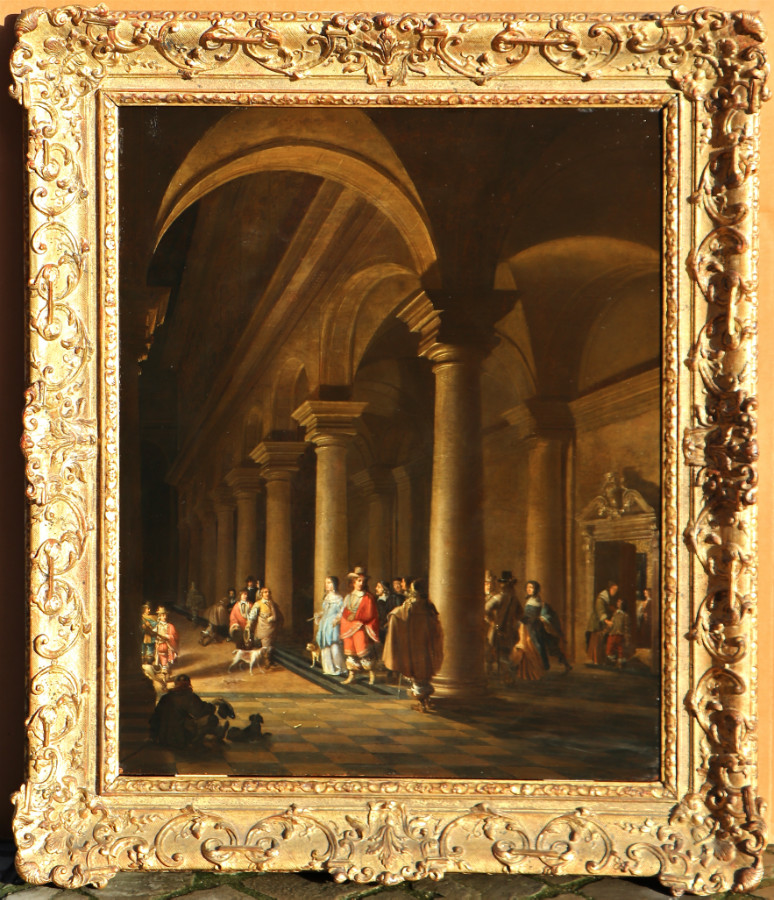
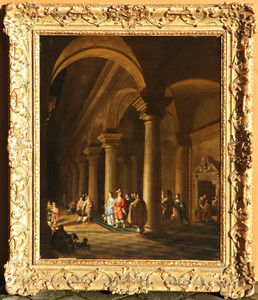
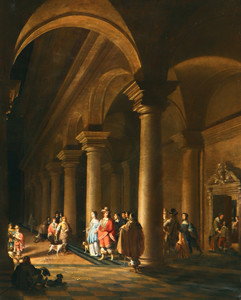
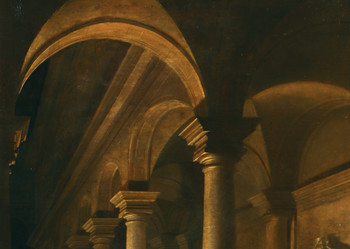
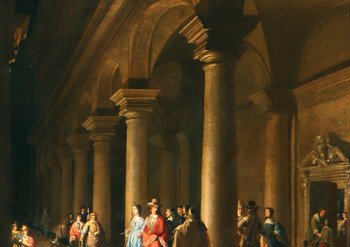
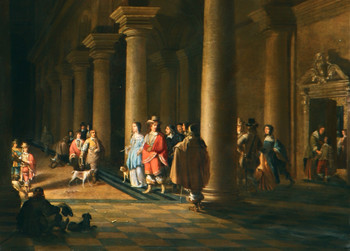
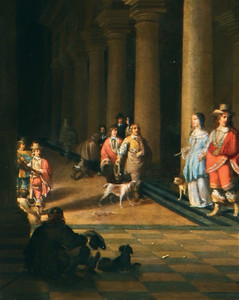
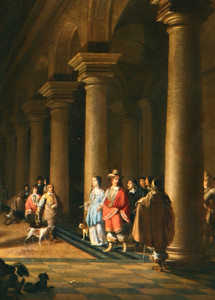
In short
De Lorme and Palamedesz. often worked together.
Anthonie Palamedesz. also painted the figure staffage for Jan van der Vucht, with whom de Lorme had probably studied under Barthold van Bassen.
Our church interior is represented at night, with strong clair-obscur contrasts, giving it a strong mysterious sense.
About Anthonie de Lorme
Dutch painter
Tournai circa 1610 – 1673 Rotterdam
His name is sometimes spelt Anthony Delorme.
Painter of church interiors.
His parents, who were Flemish, married in Antwerp, moved to Tournai (where Anthonie was born) and then almost immediately moved to Rotterdam, where they are documented from 1612 onwards.
There reigns uncertainty about whom de Lorme studied perspective painting with: Jan van der Vucht or Bartholomeus van Bassen.
According to the only ancient source (the painters index of doctor Jan Sysmus from Amsterdam) Anthonie de Lorme was a good painter of peasant fairs and of churches, and he was a pupil of Jan van der Vucht. As so often there is a serious doubt about these remarks : firstly there are no peasant fairs by de Lorme known and seeing his church interiors it would be very unlikely that he ever painted them. Secondly Jan van der Vucht was born in 1603, de Lorme circa 1610, according to some sources even a few years earlier (circa 1605), so they had approximately the same age. De Lorme did serve several times as a witness for van der Vucht, but is this enough to be seen as a base for a master-pupil relationship?
Maybe both van der Vucht and de Lorme have been pupils at the same time of Barthold van Bassen in Delft. This might explain the similarities between their art. The earliest dated painting known by de Lorme, from 1638 (sold at Sotheby’s London, 17/04/96), does indeed show the influence of van Bassen. The next one, dated 1641 (from the Hamburger Kunsthalle), reminds of van der Vucht, who had died already in 1637.
About Anthonie Palamedesz.
Dutch painter
Delft 1601 – 1673 Amsterdam
Genre and portrait painter. He often painted interior scenes, especially guardroom scenes.
Anthonie Palamedesz. regularly painted the staffage in landscapes and architectural scenes by other painters.
He was nicknamed “Stevers” after his father’s last name, Stevaert.
He was the older brother of the battle scene painter Palamedes Palamedesz. (1607 – 1638).
Arnold Houbraken (1660 – 1719) published in 1718 his famous “De groote schouburgh der Nederlantsche konstschilders en schilderessen”, a biography of all important Dutch painters. The major part of his text on Palamedes Palamedesz. and his brother Anthonie he apparently “borrowed” from an earlier book, “Beschryvinge der Stadt Delft” by Dirck Evertsz. van Bleyswijck. This future burgomaster of Delft was only 17 years old when he published in 1667 this description of his hometown and the greatest accomplishments of its citizens.
According to van Bleyswijck Palamedes Stevaert, the father of Anthonie and Palamedes Palamedesz., was a gem-cutter and sculptor from Delft who carved semi-precious stones (jasper, porphyry, agate, etc.) into vases and other decorative art. This father was of Flemish origin; he must have been one of those many Protestants who fled from Flanders and its Spanish Inquisition to Holland.
Van Bleyswijck further tells that our painters’ younger brother, Palamedes, was born while his father was at the service of King James VI of Scotland (1566 – 1625). Shortly after Palamedes’ birth he returned with his family to Delft. Van Bleyswijck mentions James as king of Scotland (which he actually became at the age of thirteen months in 1567), so it is possible that Palamedes was born in Scotland.
On the other hand we should mention that James VI, this time under the name of James I, became also king of England and Ireland in 1603; in 1607 Palamedes must therefore have been born in London instead of in Edinburgh.
Anthonie’s teacher is unknown, but it has been speculated that he may have studied in Delft with the court painter Michiel van Mierevelt and/or Hendrick Pot, who was in the city in 1620.
Palamedesz. joined the Delft Guild of St Luke in 1621 and was head man in 1653 and 1673.
He taught Ludolph de Jongh (1616-1679) and his own younger brother Palamedes Palamedesz. .
Jacob Fransz van der Merck, Jacob Jansz van Velsen and Abraham Evertsz. van Westervelt were influenced by him.
He had three children by his first marriage in 1630 to Anna Joosten van Hoorendijk (she died in1651) and a son by his second marriage in 1660 to Aagje Woedewart.
In 1673 Anthonie was residing in Amsterdam, probably with his eldest son, the painter Palamedes Palamedesz. II (1633–1705), when he died.
About the origin of the last name “Palamedesz”
In 17th century Holland the “z.” at the end of a last name stands for “zoon”, “son”. The exact pronunciation of our painters’ last name is therefore “Palamedeszoon”, meaning “the son of Palamedes”, which was the first name of Anthonie’s father.
According to the Pseudo-Apollodorus (1st or 2nd century AD) in his “Epitome” (the fourth book of the “Bibliotheca”) Palamedes was the name of the Greek hero who proved Ulysses’ madness, which he feigned so that he would not have to participate in the War of Troy, was fictitious by threatening to kill his only son Telemachus:
“ But he, not wishing to go to the war, feigned madness. However, Palamedes, son of Nauplius, proved his madness to be fictitious; and when Ulysses pretended to rave, Palamedes followed him, and snatching Telemachus from Penelope's bosom, drew his sword as if he would kill him. And in his fear for the child Ulysses confessed that his madness was pretended, and he went to the war.” (Epitome III, 7)
Ulysses never forgave Palamedes and at the end of the Trojan War he falsely accused him of treason and had him stoned to death.
In 1625 the famous Dutch author Joost van den Vondel wrote a tragedy based on this story: “Palamedes oft Vermoorde onnoselheyd” (Palamedes or the murdered stupidity).
About the church interiors of Anthonie de Lorme
The career of de Lorme can be divided in two:
- During the first half of his career he specialised in interiors of grand, imaginary, Renaissance Protestant churches. Almost all of them are shown at night, lit by candlelight.
- Circa 1652/53 de Lorme started painting direct observations in daylight, almost exclusively of the interior of the late Gothic St Lawrence church (Sint-Laurenskerk), the main Protestant church of Rotterdam. De Lorme must have turned to painting real views under the influence of contemporary architectural painters of nearby Delft, such as Gerard Houckgeest and Hendrick van Vliet. Later he was also influenced by Pieter Saenredam.
- There is one exception to this strict division of his career : the County Museum of Art in Los Angeles holds a fantasized nocturnal church interior which dates from 1660.
Why should you buy this painting?
Because de Lorme’s ambitious, imaginary Renaissance church interiors look so mysterious at night, while Palamedesz. figure staffage makes them so naturally humane.
Comparative paintings
Click photos for more details

